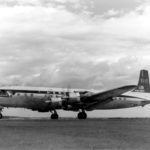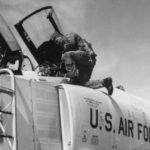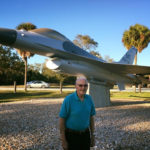Airliner left Tacoma and ditched in the ocean in October 1962
Apr 14, 2021, 8:56 AM | Updated: Oct 18, 2022, 7:03 pm
Within a period of less than a year, two identical airliners took off from McChord Air Force Base near Tacoma – now JBLM – headed for Elmendorf Air Force Base in Alaska. Both were military charters operated by Northwest Airlines, and both were known as Flight 293. Each carried active duty Air Force and Army personnel, along with spouses and children.
One Flight 293 took off on Oct. 22, 1962; the other took off on June 3, 1963. The type of aircraft for both flights was a DC-7C, a four-engine, propeller-driven airliner. Neither reached its final destination.
The June 1963 flight has been the subject of multiple stories by KIRO Radio and MyNorthwest over the past five years. That flight disappeared into the water not far from Ketchikan, Alaska, with 101 passengers and crew on board. Very little debris was found, and no cause for the crash was ever determined. Led by a Maple Valley man named Greg Barrowman, who lost his brother Bruce on the flight, an informal group of family and friends of the June 1963 Flight 293 has kept in touch by phone over the past several years, and shared their stories with KIRO Radio. They hope to create a memorial at JBLM, and are still seeking answers about what happened to that flight.
Eight months earlier, the Flight 293 of October 1962 also ended dramatically in the waters off Alaska. But, miraculously, all 102 passengers and crew aboard that flight survived.
Steve Pouliot – pronounced “POOL-yacht” – is 60 and lives in Tampa, Florida. He was doing some online research and came across the earlier MyNorthwest stories about the June 1963 crash.
“My dad was on that flight in October [1962], and my dad never talked about that our whole life,” Pouliot told KIRO Radio recently. “He always said, ‘Yeah, we ditched in the ocean on the way to Alaska’ or whatever, and that’s about all I knew about it.”
The younger Pouliot came across an old newspaper clipping 20 years ago, but he says his father Richard Pouliot was never much interested in talking about his experience aboard the October 1962 Flight 293. But that’s changed recently.
“My dad is 87 in a nursing home now, and he lived with me for eight months last year,” Steve Pouliot said. “And he’s starting to tell a story he never told.”
Nowadays, Richard Pouliot and his wife Joanne live in Minneapolis in an assisted living facility. In October 1962, he was 28 years old and was a fighter jet navigator in the Air Force. Both Richard Pouliot and Joanne Pouliot were born and raised in Minnesota, and at that time, their family consisted of four young kids.
The elder Pouliot left Minneapolis on a Sunday, headed to a new assignment in Alaska that meant leaving his family behind for most of a year. For the final northward leg of the trip, Pouliot flew out of McChord Air Force Base just before 9 a.m. on the morning of Monday, Oct. 22 – which, incidentally, was the day after the Seattle World’s Fair had ended.
There were 95 passengers and seven civilian crew members from Northwest Airlines on board Flight 293 that October. Along with his own gear, Richard Pouliot was traveling with a bag of classified documents – which was just part of the job when you fly for the Air Force – and which he supervised while the bag was stowed safely in the luggage compartment of the airliner.
Takeoff from McChord was routine, with the prop plane gradually climbing thousands of feet into the cloudy autumn skies above the Pacific Northwest and heading north. The DC-7C had been in the air for about three hours and had just climbed to 20,000 feet when a voice on the intercom said that there was a problem.
“I don’t remember the exact words, but they told us we had a runaway propeller and we kind of knew what that was,” Richard Pouliot told KIRO Radio. “It was on the left inboard engine, and they said that the propeller really winds up and it gets quite hot and it can either tear off, and hopefully tear off free and get out of there without doing anything, or it could chop into the good engine on the left, which means we only had two on the right side, or it could chop into the fuselage, which means your controls to the rear are all taken care of.”
In this case, the phrase “all taken care of” – in the words of a seasoned civilian flyer and longtime military aviator – mean completely wiped out. Investigators later blamed a malfunctioning supercharger for the failed engine and “overspeeding,” or dangerously out of control, propeller.
With no rear controls “you kind of fly like a rock,” Pouliot said. With this imminent threat from the runaway propeller – spinning out of control and getting dangerously hot – the pilot of the airliner took fast action.
The plane “immediately started to descend, to get right down close to the water, … I’d say maybe 500 feet, something like that,” Pouliot said.
At this point, the plane was north of Annette Island, and reaching the nearest airport would have required flying over mountains. The decision was made by the pilots to fly only over the water to reach an airport farther away.
The pilots radioed for help, and the steward and two stewardesses aboard prepped the passengers for a water landing. They gave everyone “Mae West” life vests, and told them how to brace for impact. They moved passengers out of the danger zone where the propeller might tear through the cabin. This meant that Richard Pouliot – sitting near the back of the plane — had another passenger sitting on the floor between his feet.
For the next 45 minutes or so, the plane headed north over the water toward the airport at Gustavus, near Glacier Bay.
They didn’t make it.
“The prop never did tear off, but the engine just completely burst into flames,” Pouliot said. “And the movement through the air brings those flames back over the wing, and the wing is where the fuel tanks are. Anyway, soon as we caught fire, why, we were down there close enough to the water that [the pilot] just pulled the throttles back, I think made about a 45-degree turn to the left, and set it down.”
The landing consisted of two thumps – initial contact with the choppy water, and then one more impact.
“We did have one heck of a big jolt,” Pouliot said. “And then the airplane actually bounced and we had a second big jolt and then came to a stop.”
Remarkably, within five minutes, even as water began filling the cabin, the 95 passengers and seven crewmembers had all evacuated and climbed into five inflatable life rafts.
On board the raft he’d jumped into from the rear door of the plane, Richard Pouliot was just sitting back, relaxing, and counting his blessings.
First, he found a dye packet in the raft and dumped it in the water to mark the crash site in case there was to be a search for the classified documents. Then, he had to find the knife in the raft’s emergency kit so he could reach over and cut a rope from the raft that a crew member had tied to one of the airliner’s seats – so the raft wouldn’t float away during evacuation.
“I reached down and cut that rope that was tying us to the airplane so we could get the heck away from it,” Pouliot said.
How did it feel for this seasoned Air Force aviator to get through that low-altitude flight, the water landing, and rapid evacuation?
“If I can use a colloquial old fighter-type analogy,” Pouliot said, hesitatingly slightly but then chuckling, “your butt-end sucks up a little seat cushion.”
The evacuation, Pouliot said, was actually smooth and fairly uncomplicated. And he credits the skill of the pilot for executing a safe landing, and the crew for being well-prepared.
“Everybody resigned themselves to following instructions, … crew members were by the other doors, and you had an exit over the wing,” Pouliot said. “The last ones out of there were actually standing in a couple feet of water on top of the wing, and they were able to float the raft right up over the wing so they could step in.”
As the entire cohort of 102 passengers and crew were sitting in the rafts in moderate swells in the chilly water – this was about 23 minutes after the plane touched down, and about 18 minutes after everyone had evacuated – the DC-7C had gotten pretty low in the water. Then it pulled a bit of a “Titanic” move.
The aircraft was “sitting there with just the dome of the top of the fuselage and the tail showing,” Pouliot said. “All of a sudden, the nose goes down, the tail comes way straight up out of the water, and then plane went straight down.”
With 45 minutes between Flight 293’s first MAYDAY and its ditching in the ocean, it didn’t take long for everyone to be rescued. First on the scene was a 50-foot wooden boat called FEDAIR I. It was owned and operated by the FAA, as a supply boat for the FAA navigation aids facility on nearby Biorka Island. Remarkably, the FEDAIR I – renamed “Biorka” – is still afloat, though now in private hands.
From the FEDAIR I, the passengers and crew transferred shortly after to the Coast Guard Cutter SORREL, which took them to Sitka, about 20 miles away.
Richard Pouliot was given access to a phone right away to report the missing classified documents, and he was also able to call his wife and let her know that he was OK. Later that evening, resting at the hospital in Sitka, the group of Flight 293 passengers watched President Kennedy on TV announcing the presence of Soviet missile bases in Cuba. This was the height of the Cold War, after all, which Pouliot and his military colleagues were all well aware of.
Within a few days, Richard Pouliot and the others finally made it to Elmendorf Air Force Base, and he began his new assignment in Alaska. It was about eight months later, when he was back at the base and witnessed a flurry of activity that indicated something unusual had happened. He then learned about the missing Flight 293.
In the years since, Pouliot and his wife have often remarked on the similarities and one very stark difference between the two flights.
“We’ve said that many times I think, right, Jo?” – Pouliot said, addressing his wife who was sitting nearby while he spoke to KIRO Radio – “’Glad you were on the first one and not the second one,’ or something like that?”
Richard Pouliot continued with his Air Force career and retired in 1978. And while the experience as a passenger aboard Flight 293 was clearly not a major defining event in his life – and something he only reluctantly talks about – he says memories of that long-ago October experience have sometimes come up over the years.
He, of course, couldn’t help but see the similarities between his flight and the “Miracle on the Hudson” of 2009, and he acknowledges that his own water landing sometimes comes to mind while traveling by jetliner to visit family in Florida.
“We would fly into Florida to Tampa,” Pouliot said. “And on a direct route, I believe you kind of cut over Tampa Bay there and the Gulf, so it has crossed my mind, yes. And actually, as a matter of fact, it was more comforting to know that the water was there, because if you had to go down, I’d much rather and go into the water then go on land where there was no airport.”
Memories of the ditching came up much earlier, too, when, not long after his assignment in the far north ended, he was asked to crew a fighter plane on a delivery flight to Vietnam, via Hawaii and Guam. That meant crossing a lot of open water.
“You had those thoughts in the back of your mind,” Pouliot said. “But I guess I felt somehow I needed to prove to myself that I could still do it.”
Safety equipment on the fighter jet offered some reassurance.
“If you went out there and ejected [from the plane], you did have in your survival kit a one-man raft,” Pouliot said.
“But it was a big ocean,” Pouliot said. “And yes, it crossed my mind.”
You can hear Feliks every Wednesday and Friday morning on Seattle’s Morning News, read more from him here, and subscribe to The Resident Historian Podcast here. If you have a story idea, please email Feliks here.



























